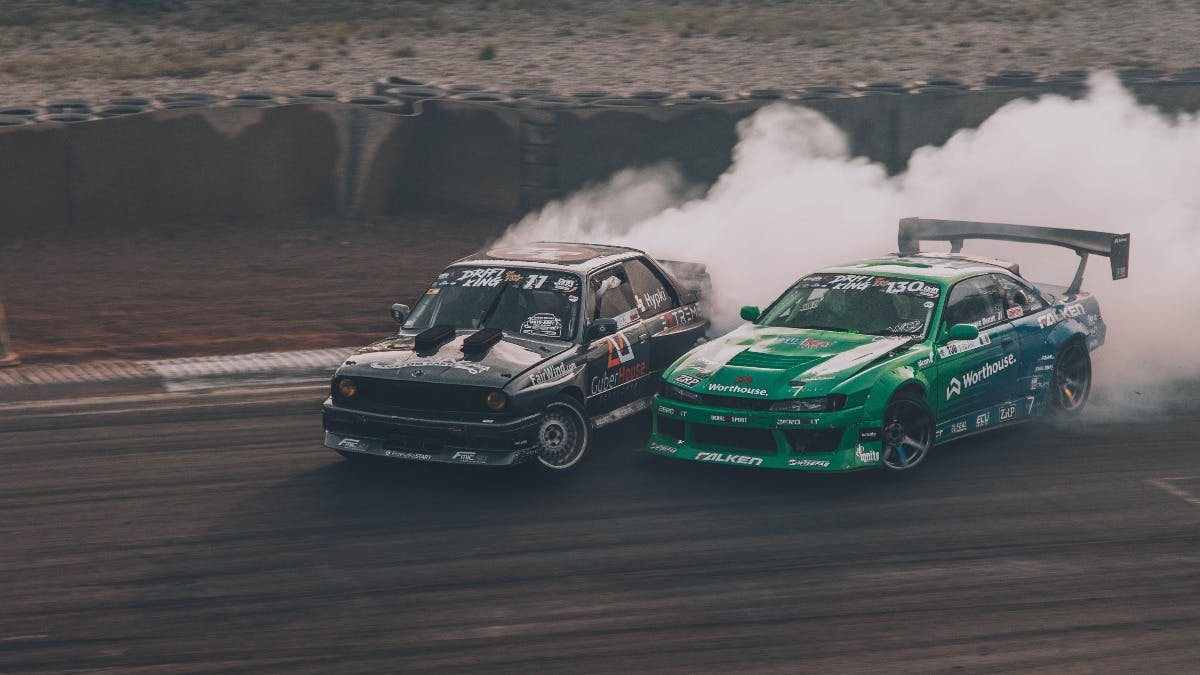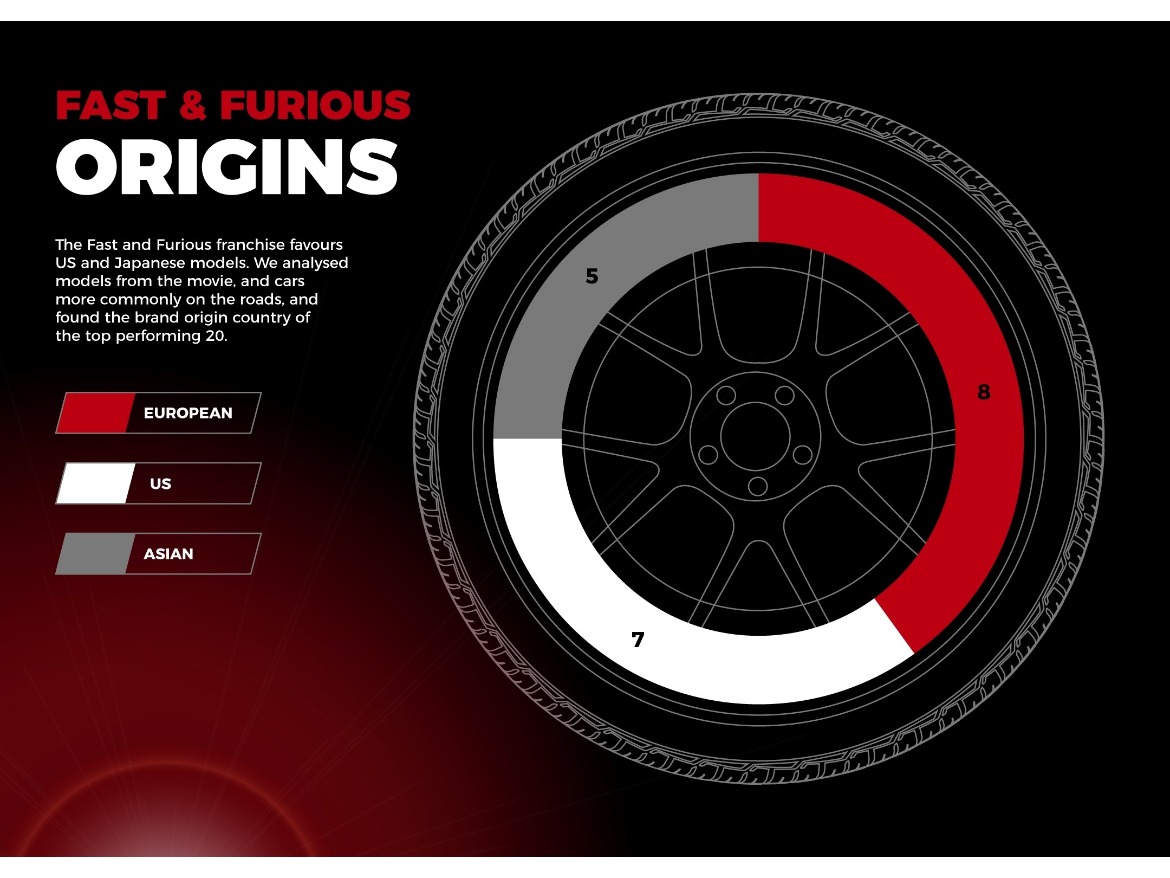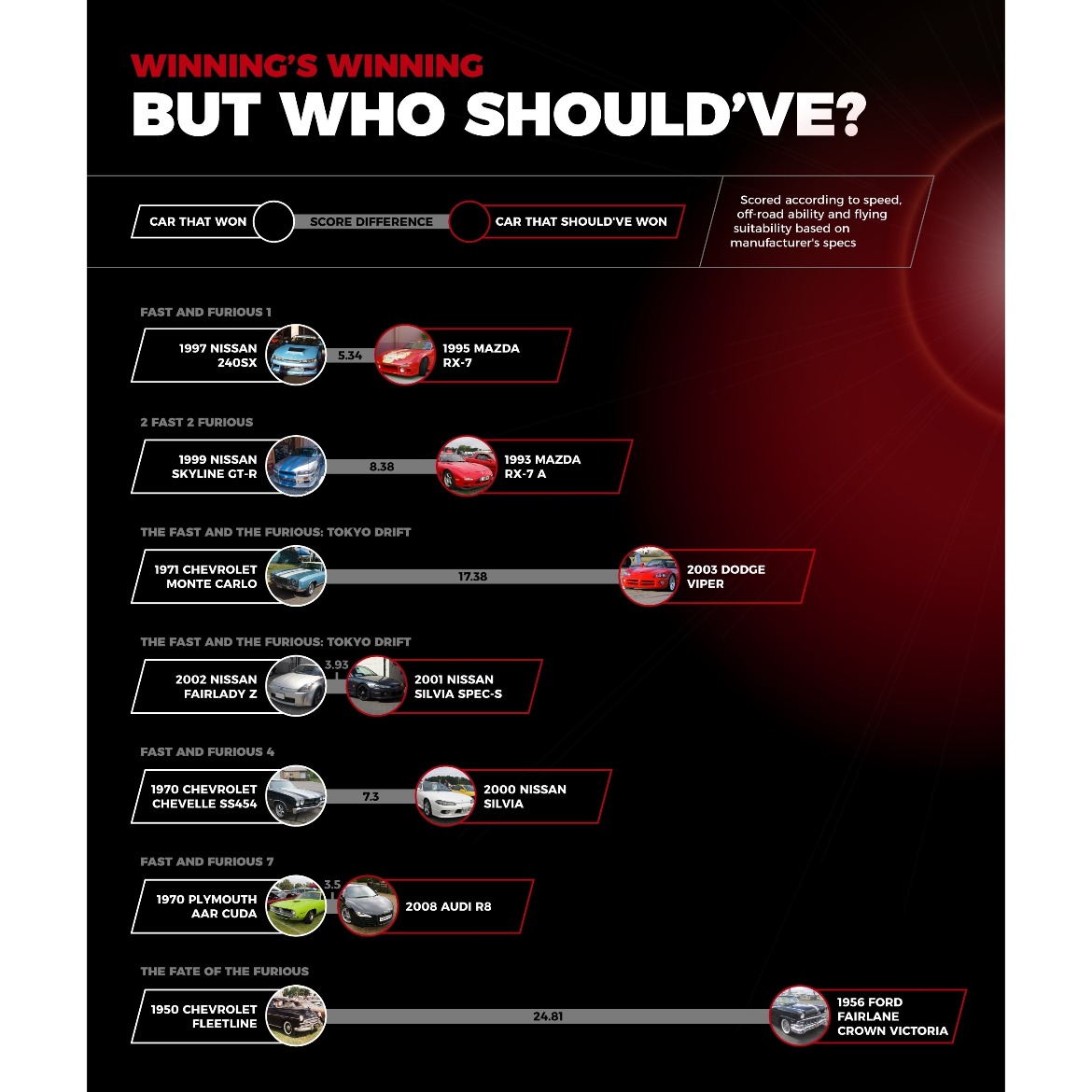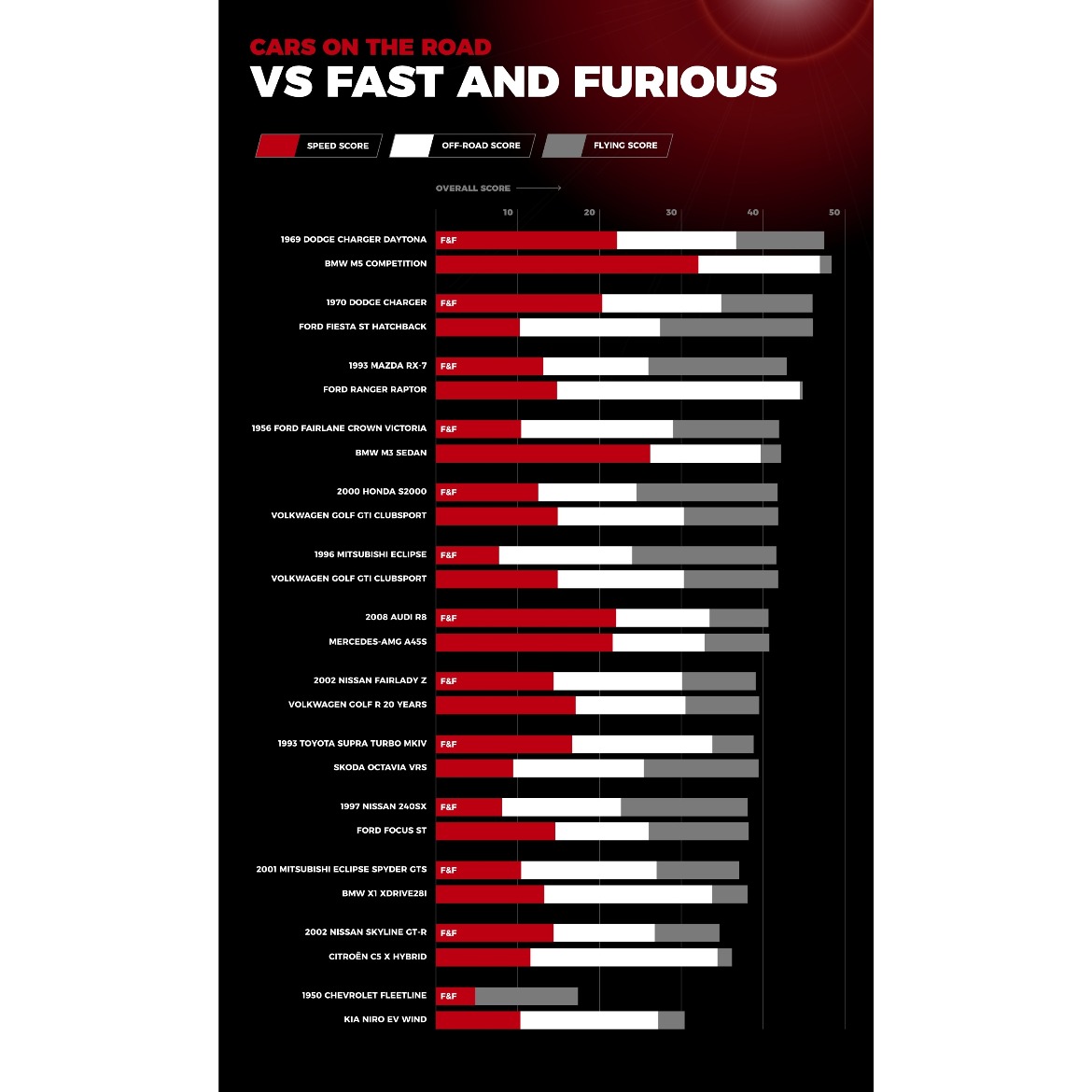Not So Fast and Furious? The Cars That Could’ve Won

-
With the upcoming film in the ‘Fast and Furious’ franchise set to be the penultimate one, the chapter is almost closing for Dominic Toretto and the storylines that are both loved and hated by cinemagoers. Whatever your opinion on the franchise and how it has evolved over time, it’s beyond doubt that it has had a massive impact on the cinema industry and has provided a cultural talking point that transcends generations and borders.
We wanted to examine the cars that won vs. the cars that should’ve won, as well as the more common, on-the-road vehicles currently available that would give them a run for their money head-to-head. Of course, cars driven by the likes of Dom Toretto, Letty, or O’Conner have the power to triumph over more powerful vehicles, and we can’t forget the difference that selected mods or a well-timed NOS boost can make. We worked under the assumption of the original manufacturer’s specs to get baseline values for all the cars in our study prior to any mods or additional alterations that could have impacted race outcomes.
-

-
When it comes to the franchise, there’s clearly a preference for the origin countries of brands, for example throughout the films we typically see Japanese and US models. Given the franchise started out portraying the burgeoning street race scene, the affination for Japanese vehicles is hardly surprising. The movies promoted the tuner scene in the USA, which meant that Japanese and US vehicles were much more likely to have been used than European models, for example. Since then, illegal street racing has gone global, with pockets of communities in places like California, Japan, Denmark, and even the UK.
As such, we wanted to see what the origin story would look like if we analysed across the most powerful vehicles in the ‘Fast and Furious’ films versus the vehicles that have equivalent power and are more commonly seen on UK and European roads. In contrast to what the films portray, European manufacturers have the highest number of vehicles in our top-performing 20.
-
Winning’s winning, but who should’ve?
The films have often been critiqued for vehicles winning street races in unlikely circumstances, or outperforming cars that would’ve beaten them based on their performance regarding manufacturer’s specifications alone. We analysed performance suitability based on speed, off-road ability, and flying potential to see which vehicles would come out on top.
We worked in chronological order of some of the races that feature within the films, analysing which would’ve had closer races, and which would’ve lost if it hadn’t been for mods, NOS boosts, and how much it matters who is behind the wheel.
-

-
The first race we analysed featured in Fast and Furious 1 (2001) and saw Letty cooly beat Man in her Nissan 240SX at the first race of Race Wars. While Letty easily beats Man in this first race, based on our index, the 1995 Mazda RX-7 that Man raced could’ve just pipped her. After initially looking like a close call, Letty’s NOS boost toward the end of the race ultimately secured her the win. But based on specs alone, the Mazda would’ve had a 5.34- point advantage when compared to all of the cars in our study.
Of the races we examined, one of the ones with the highest point difference features in The Fast and the Furious: Tokyo Drift, where Sean Boswell’s 1971 Chevrolet Monte Carlo beat Clay’s 2003 Dodge Viper despite the Viper having a 17.38 point advantage. Quoting, “it’s not the ride, it’s the rider,” Boswell ultimately wins the race for Clay’s girlfriend’s heart after initially being belittled for his car. Racing through a cordoned-off estate, with a truck containing other students blocking the path, Boswell decides to take his Monte Carlo off-road resulting in both cars crashing into one another to push the other off track, Boswell secures the win but both cars are written off in the process.
The Fate of The Furious sees equally unlikely circumstances when the 1950 Chevrolet Fleetline manages to beat the 1956 Ford Fairlane Crown Victoria despite the Ford having an almost 25-point advantage. The race is widely seen as ludicrous, with Dom securing the win backward while on fire after Raldo’s attempts at cheating. Despite Dom’s cousin insisting that Raldo has the fastest car on the island, Dom quotes “he knows it doesn’t matter what’s under the hood, the only thing that matters is who’s behind the wheel”, with a race through the streets of Cuba ensuing.
We wanted to take this a step further and pit cars that won their races in Fast and Furious against some of the more common performance and standard vehicles that you may see on the roads in the UK or Europe. While some of these races would be much closer than others, the models that would have the potential to go up against some of the best cars in the franchise might surprise you.
-

-
-
As it turns out, the 1950 Chevrolet Fleetline that Dom drove to the win in The Fate of the Furious would find its match against the Kia Niro EV Wind based on specs alone, but as we’ve seen from the franchise, racing tactics and who's behind the wheel could tip the odds in the unlikeliest of favours. While the Kia scored higher for speed and off-road handling, the Chevrolet scored much higher for flying potential.
Meanwhile, the 2002 Nissan Fairlady Z driven by Takashi/DK in Japan could find a strong competitor in the Volkswagen Golf R 20 Years. The Golf scored slightly higher for speed on our index, while the Nissan performed better off-road, and both had equal standing when it came to flying potential. If we were to see a race similar to that in Tokyo Drift, where Boswell relied on off-road handling to outperform speed, there’s a chance that the Nissan could steal the win.
And perhaps in some of the most surprising cases of our study, a trusty Ford model could make a close match for one of the most iconic cars in the franchise, one of Dom’s Dodge Chargers, the 1970 to be precise. The Ford Fiesta is one of the best-selling vehicles in the UK, with over 4.1 million sales since 1976, with the model proving popular amongst first-time drivers and small families alike.
But surprisingly, the sportier Ford Fiesta ST Hatchback could match the 1970 Dodge Charger, the second-highest performing car in the franchise, of those that won. While the margins are narrow (0.6 of a point!), the notion that a trusty hatchback could come anywhere close to a muscle car favoured by the legendary Dom Toretto, is nothing short of surprising. Similarly, the Ford Focus ST also makes for a pretty close competitor against the 1997 Nissan 240SX that Letty raced in the first film to steal the win against the 1995 Mazda RX-7, with the Ford having a 0.13 point advantage.
The Honda S2000 has been widely acclaimed as one of the best-performing vehicles within the franchise, with Suki racing her neon pink 2001 Honda S2000 in 2 Fast 2 Furious, but ultimately losing against the other cars in the ‘Bridge Race’ including O’Conner’s Nissan Skyline. In the first film, Tran races against Jesse in the S2000 against the MK3 Volkswagen Jetta to secure the win. Johnny’s S2000 could face a Volkswagen Golf GTI Clubsport, with the Volkswagen having a marginal advantage.
All in all, love it or hate it, the Fast and Furious franchise is projected to wrap up in the coming years. And amongst the Hollywood storylines, the revered one-liners, and quasi-impossible circumstances, it’s undeniable that the films have had a massive impact on the cinema industry. So, whether or not you agree with Toretto that it doesn’t matter what’s under the hood, it’s who’s behind the wheel, winning’s winning, but here’s some of the cars we think could’ve had a fair shot.
-
Methodology
We began with a seed list of vehicles from Fast and Furious movies, gathering data on manufacturer’s specifications to gain an insight into their performance in terms of speed, off-road ability, and flying potential. We then indexed cars that are more commonly on the roads against the same metrics to derive a comparison.




